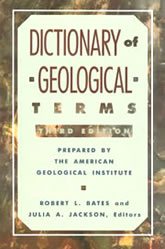Geological Terms Beginning With "G"
For terms beginning with other letters, please click below
|
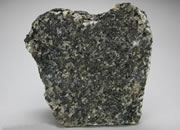

Gage Height
A measured height of water above an arbitrary reference datum. Frequently used to describe the height of water in a stream, lake, well, canal, or other water body. Stage and gage height are equivalent words, with stage being more commonly used by the public. Gage height is usually measured at a gaging station.
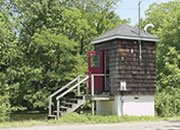
Gaging Station
A facility on a stream, lake, canal, reservoir, or other water body where instruments are installed to automatically monitor the water. Measurements such as stage, discharge, water temperature and pH are automatically taken and transmitted to hydrologists via satellite, radio, or telephone. Measurements from these stations are useful for a wide variety of flood prediction, water management, recreation, and navigation purposes.
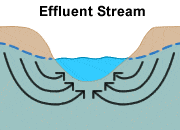
Gaining Stream
Also known as an "effluent stream." A stream that gains water from groundwater flow. These streams are typical of humid climates where water tables are high. The discharge of an effluent stream can be sustained by groundwater flow for long periods of time between runoff-producing rainfall or snowmelt. Effluent streams generally increase in discharge downstream and contain water throughout the year. The opposite is an influent stream.

Garnet
Garnet is the name of a group of silicate minerals that share a common crystal structure, but they vary in composition. Most garnets are red in color, but the mineral also occurs in orange, yellow, purple, green, pink, black, and other colors. Shown in the photo, clockwise from top left, are the gem garnets: spessartine, almandine, tsavorite, rhodolite, and mali (center). In addition to being used as a gemstone, garnet is used as an abrasive, filter medium, sand-blasting granule, and waterjet cutting granule.
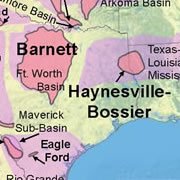
Gas Field
The geographic area that is directly above an underground accumulation of natural gas which is commercially viable. The image shows the geographic extent of the Barnett, Haynesville, and Eagle Ford gas fields.
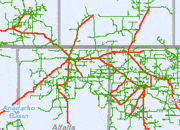
Gathering System
A network of small pipelines that connect producing wells to the main transmission system.

Gemstone
There is no universally agreed-upon definition for the word "gemstone." The word usually triggers an image of attractive mineral materials that have been fashioned into gems to be worn for personal adornment. Some people believe that gemstones should also be durable, rare, valuable, and skillfully cut - but some items formally called "gemstones" lack all of these features. Many gemstones are rocks, organic materials, mineraloids, or even objects from space that lack durability, rarity, intrinsic value, and are used in their natural state. As an example, consider a small pearl used in an inexpensive necklace sold at Walmart. Hundreds of materials have been used as gemstones; see photos of over 100 here.

Geode
A geode is a rock structure that has an internal cavity lined with mineral materials. The mineral lining is often a scintillating druze of tiny quartz crystals underlain by multiple bands of translucent gray and white agate. Many are lined with more spectacular treasures, such as rich purple amethyst, perfect white calcite crystals, or colorful banded agate.
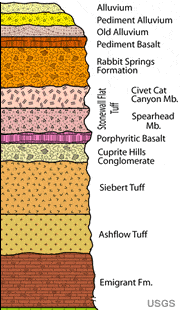
Geologic Column
A diagram that shows the vertical sequence of rock units present beneath a given location, with the oldest at the bottom and youngest at the top. They are typically drawn to approximate scale with proportional rock unit thicknesses. Colors and standardized symbols are usually added to graphically communicate rock types and some of their more important features. Geologic columns prepared for regions will have generalized thicknesses and rock unit features that show relationships which change over distance.

Geology
Geology is the study of the Earth, the materials of which it is made, the structure of those materials, and the processes acting upon them. It includes the study of organisms that have inhabited our planet. An important part of geology is the study of how Earth’s materials, structures, processes, and organisms have changed over time.
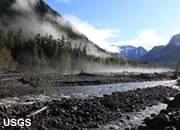
Geomorphology
The study of Earth's surface, including the origin, description, and classification of landforms such as mountains, valleys, drainage systems, coastlines, and ocean basins. It includes the processes that form them and how they are influenced by the underlying bedrock.

Geotechnical
Refers to the use of geology as a science when applied to an engineering problem such as landfill design, highway construction, landslide repair, tunnel construction, sewage system design, and much more.
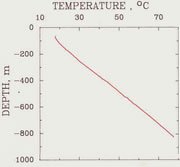
Geothermal Gradient
The progressive increase of temperature with depth into the Earth. Often displayed graphically as a chart similar to the image at left, which shows the geothermal gradient in the Carson Sink area of Nevada from a USGS report.
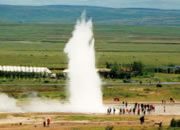
Geyser
A hot spring that intermittently erupts a spray of steam and hot water. Caused by the heating of groundwater within a confined opening in hot rock.
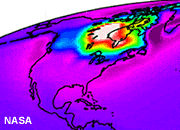
Glacial Rebound
A very gradual uplift of Earth's crust that occurs after the weight of a thick continental ice sheet (which produced subsidence) has melted away.
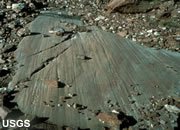
Glacial Striations
Grooves and scratches on a bedrock surface that were produced by the movement of a glacier. The orientation of the striations gives evidence to the direction of glacial movement.
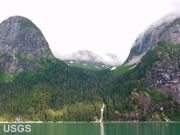
Glacial Valley
A valley with a U-shaped cross section that was cut by an alpine glacier.

Glacier
A thick mass of ice that forms on land, from an accumulation and recrystallization of snow significant enough to persist through the summer and grow year by year. There are two basic types of glaciers: 1) valley (or alpine) glaciers that creep downslope under the influence of gravity, and 2) continental glaciers that flow outward from a thick central area under their own weight.

Glass
In geology, an amorphous (without crystal structure) igneous rock that forms from very rapid cooling of magma. The rapid cooling does not provide enough time for crystal growth. Shown in the image is a piece of obsidian.
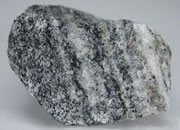
Gneiss
A coarse-grained, foliated rock produced by regional metamorphism. The mineral grains within gneiss are elongated due to pressure, and the rock has a compositional banding due to chemical activity.
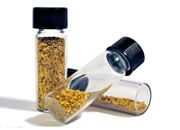
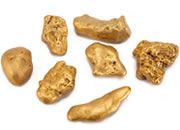
Gold Nugget
A piece of native gold that has been weathered out of its host rock. Nuggets are found in placer deposits downslope from a lode. They might be found in soils, stream sediments, or beach sediments. Nuggets are often smoothed and rounded, which is evidence of transport. They sometimes still contain pieces of host rock. They are generally not pure gold, instead being natural alloys with silver or copper that are 80% to 95% gold. Image copyright iStockphoto / Goruppa.

Goshenite
Goshenite is the name of colorless specimens of the mineral beryl. Although they are seldom seen in jewelry, the faceted gems are popular with gem collectors. Crystals of gem-quality goshenite are also popular with mineral collectors.
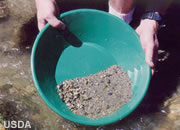
Gold Pan
A broad, shallow pan made of metal or rigid plastic that is used to separate the lighter fraction of a sediment from heavier grains. A shovel of stream sediment or soil is placed in the pan, the rocks are picked out and clinging soil or sediment scraped off, then the pan and sediment are immersed in the stream and moved in a manner that allows lighter grains to be removed by the current or sloshed over the rim of the pan. Considerable practice is required, but an experienced person can separate sand, silt, and mud from particles of gold or heavy mineral that are so small, they can barely be seen. View a gold panning demonstration. View gold panning supplies in the Geology.com Store.
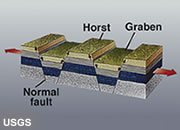
Graben
An elongated, downthrown block bounded by two normal faults that dip steeply in opposite directions. Produced in an area of crustal extension. This is the dominant structural style of the Basin and Range province of the southwestern United States. Death Valley, Salt Lake Valley, and Owens Valley are all grabens in that province.
|
Dictionary of Geological Terms - Only $19.99 All scientific disciplines have an essential vocabulary that students and professionals must understand to learn and communicate effectively. A geology dictionary that is used regularly is one of the most important tools for developing professional competence. A good dictionary should be on the desk of every geologist and within easy reach. This dictionary is compact and inexpensive at only $19.99. More information. |
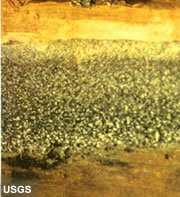
Graded Bedding
A rock or sediment layer that has a progressive change in particle size from top to bottom. Most common is a sequence with coarse grains at the bottom and fining upwards, which is typically caused by a declining current velocity within the depositional environment.

Granite
A coarse-grained, intrusive igneous rock composed primarily of light-colored minerals such as quartz, orthoclase, sodium plagioclase, and muscovite mica. Granite is thought to be one of the main components of continental crust. Granite is also used as a dimension stone for kitchen countertops, building stone, paving stone, tile, memorials, facing stone, curbing, and many other uses.
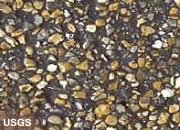
Granule
A term used for a sedimentary particle that is between 2 and 4 millimeters in size. Granules are larger than sand but smaller than pebbles. Granules have typically been rounded by abrasion during sedimentary transport.

Gravel
Clastic sedimentary particles of any composition that are rounded and over 2 mm in diameter. Includes granules, pebbles, cobbles, and boulders. If lithified, an accumulation of gravel would produce the sedimentary rock known as conglomerate. The image shows an accumulation of gravel on the surface of Mars discovered by Mars Rover Curiosity in 2012. The largest particle in the photo is about one centimeter in length.
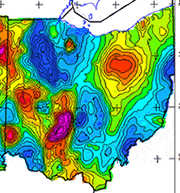
Gravity Anomaly
A geographic area where observed gravity values depart from those of the assumed Earth model. They are typically a response to lateral density differences within the Earth, caused by variations in geologic structure or crustal composition. The image is a Bouguer gravity anomaly map of the state of Ohio.
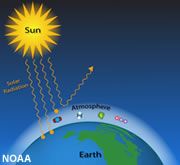
Greenhouse Effect
A warming of the atmosphere, caused by carbon dioxide and water vapor in the lower portions of the atmosphere capturing heat that is radiated from and reflected by Earth's surface.
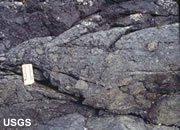
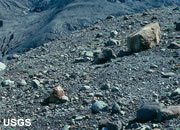
Ground Moraine
A blanket of till that is deposited during the retreat of a glacier, producing a rocky ground cover made up of material that ranges in size from clay to boulders. Much of this debris was carried beneath the glacier, but some was contained within the ice and released by melting.
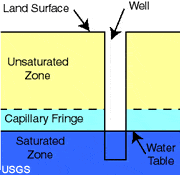
Groundwater or Ground Water ?
Water that exists below the water table in the zone of saturation. Groundwater generally moves slowly in the same direction that the water table slopes.
Today most geologists and hydrologists use "groundwater" in their writings. The term "ground water" appears more frequently in writings that were published in the 1990s and earlier. Geology.com uses "groundwater" in almost every situation because we believe that it is the preferred term today.
We will use "ground water" when we quote from the work of another organization or when those words appear in the title of a publication in one of our citations.
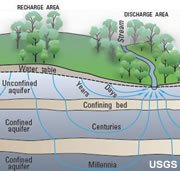
Groundwater Recharge Area
A location where surface water or precipitation can infiltrate into the ground and replenish the water supply of an aquifer.
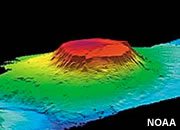
Guyot
A seamount with a flat top. They are usually shield volcanoes that have a flat top produced by wave erosion. Shown in the image is the Bear Seamount of the North Atlantic Ocean, about 200 miles east of Woods Hole, Massachusetts.
|
| More General Geology |
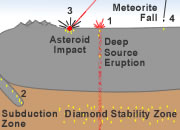 |
Diamonds from Coal? |
 |
What is a Geyser? |
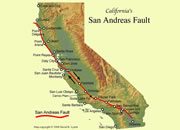 |
What is the San Andreas Fault? |
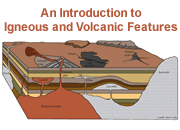 |
Igneous and Volcanic Features |
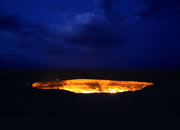 |
The Doorway to Hell |
 |
Topo Maps |
 |
Geology Dictionary |
 |
Gifts That Rock |

Find Other Topics on Geology.com:

|

| ||

|

| ||

|

| ||

|

|

